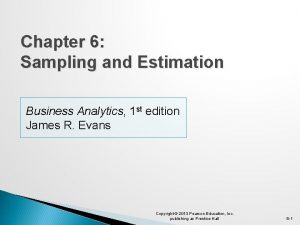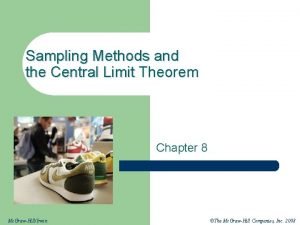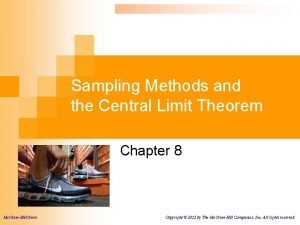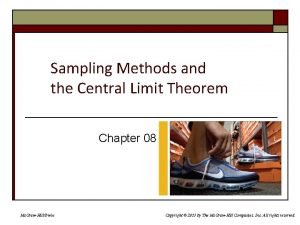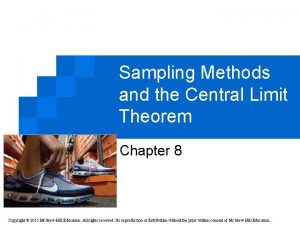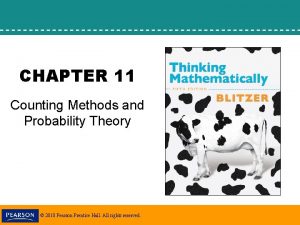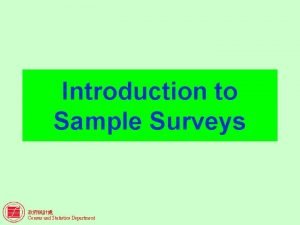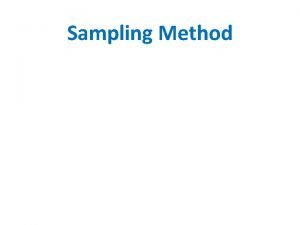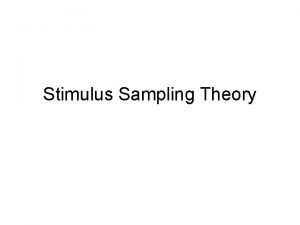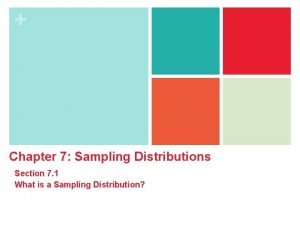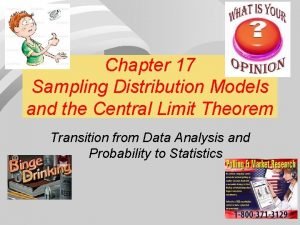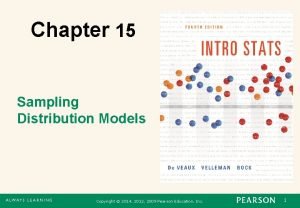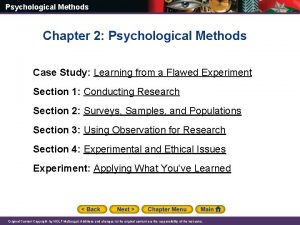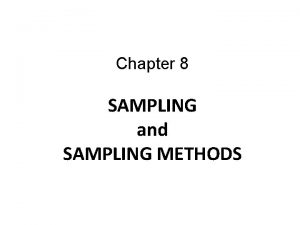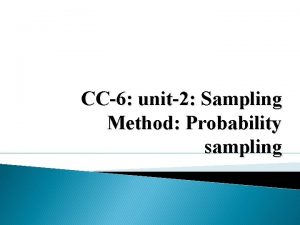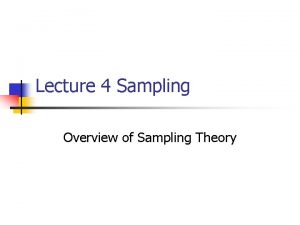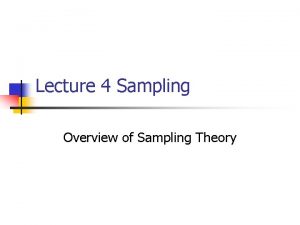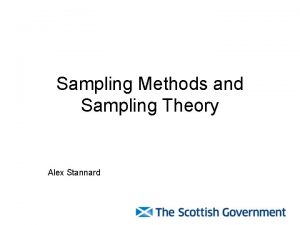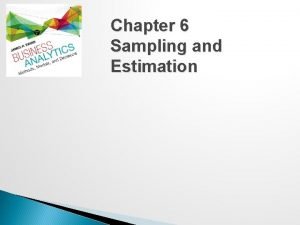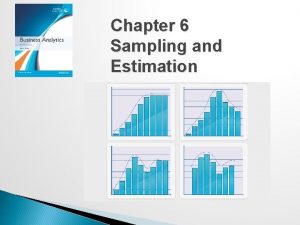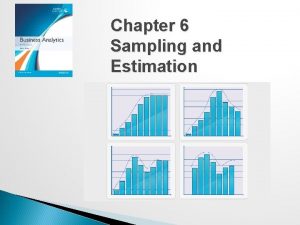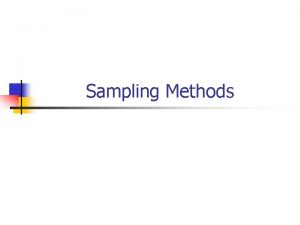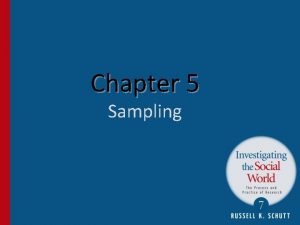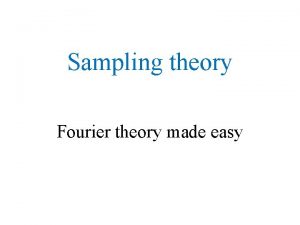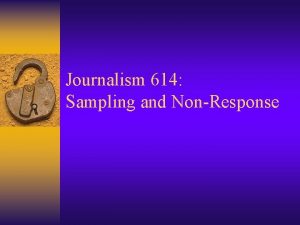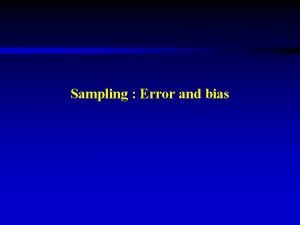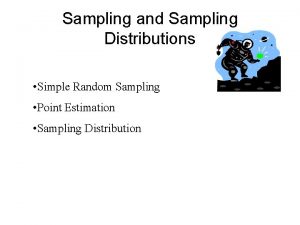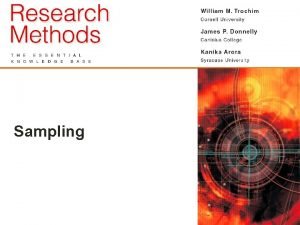Chapter 6 Sampling Theory and Methods Mc GrawHillIrwin




























- Slides: 28

Chapter 6 Sampling: Theory and Methods Mc. Graw-Hill/Irwin Copyright © 2013 by The Mc. Graw-Hill Companies, Inc. All rights reserved.

Learning Methods • Explain the role of sampling in the research process • Distinguish between probability and nonprobability sampling • Understand the factors to consider when determining sample size • Understand the steps in developing a sampling plan 6 -2

Value of Sampling in Marketing Research • Sampling: – Selection of a small number of elements from a larger defined target group of elements – Expecting that the information gathered from the small group will allow judgments to be made about the larger group 6 -3

Sampling as a Part of the Research Process • Sampling is used when it is impossible or unreasonable to conduct a census – Census: A research study that includes data about every member of the defined target population 6 -4

The Basics of Sampling Theory • Population: An identifiable group of elements of interest to the researcher and pertinent to the information problem • Defined target population: The complete set of elements identified for investigation – Sampling units: The target population elements available for selection during the sampling process • Sampling frame: The list of all eligible sampling units 6 -5

The Basics of Sampling Theory • Factors underlying sampling theory – Central limit theorem (CLT): The sampling distribution derived from a simple random sample will be approximately normally distributed 6 -6

The Basics of Sampling Theory • Two difficulties associated with detecting sampling error: – A census is very seldom conducted in survey research – Sampling error can be determined only after the sample is drawn and data collection is completed 6 -7

The Basics of Sampling Theory • Tools used to assess the quality of samples: – Sampling error: Any type of bias that is attributable to mistakes in either drawing a sample or determining the sample size – Nonsampling error: A bias that occurs in a research study regardless of whether a sample or census is used 6 -8

Probability Sampling • Each sampling unit in the defined target population has a known probability of being selected for the sample Nonprobability Sampling • Sampling designs in which the probability of selection of each sampling unit is not known • The selection of sampling units is based on the judgment of the researcher and may or may not be representative of the target population 6 -9

Exhibit 6. 2 - Types of Probability and Nonprobability Sampling Methods 6 -10

Probability Sampling Designs • Simple random sampling: A probability sampling procedure in which every sampling unit has a known and equal chance of being selected • Systematic random sampling: Similar to simple random sampling but the defined target population is ordered in some way – Usually in the form of a customer list, taxpayer roll, or membership roster, and selected systematically 6 -11

Exhibit 6. 3 - Steps in Drawing a Systematic Random Sample 6 -12

Probability Sampling Designs • Stratified random sampling: Separation of the target population into different groups, called strata, and the selection of samples from each stratum – Proportionately stratified sampling: A stratified sampling method in which each stratum is dependent on its size relative to the population – Disproportionately stratified sampling: A stratified sampling method in which the size of each stratum is independent of its relative size in the population 6 -13

Probability Sampling Designs • Cluster sampling: A probability sampling method in which the sampling units are divided into mutually exclusive and collectively exhaustive subpopulations, called clusters – Area sampling: A form of cluster sampling in which the clusters are formed by geographic designations 6 -14

Nonprobability Sampling Methods • Convenience sampling: A nonprobability sampling method in which samples are drawn at the convenience of the researcher • Judgment sampling: A nonprobability sampling method in which participants are selected according to an experienced individual’s belief that they will meet the requirements of the study 6 -15

Nonprobability Sampling Methods • Quota sampling: A nonprobability sampling method in which participants are selected according to pre-specified quotas regarding demographics, attitudes, behaviors, or some other criteria • Snowball sampling: A set of respondents is chosen, and they help the researcher identify additional people to be included in the study – Called referral sampling 6 -16

Exhibit 6. 4 - Factors to Consider in Selecting the Sampling Design 6 -17

Probability Sample Sizes • Factors that determine sample sizes with probability designs: – Population variance and population standard deviation – Level of confidence desired in the estimate – Degree of precision desired in estimating the population characteristic • Precision: The acceptable amount of error in the sample estimate 6 -18

Probability Sampling and Sample Sizes • When estimating a population mean: • Where, – ZB, CL = The standardized z-value associated with the level of confidence – σμ = Estimate of the population standard deviation (σ) based on some type of prior information – e = Acceptable tolerance level of error (stated in percentage points) 6 -19

Probability Sampling and Sample Sizes • Situations where estimates of a population proportion are of concern: • Where, – ZB, CL = The standardized z-value associated with the level of confidence – P = Estimate of expected population proportion having a desired characteristic based on intuition or prior information – Q = — [1 — P], or the estimate of expected population proportion not holding the characteristic of interest – e = Acceptable tolerance level of error (stated in percentage points) 6 -20

Sampling from a Small Population • Use of previous formulas may lead to an unnecessarily large sample size • Calculated sample size should be multiplied by the following correction factor: • Where: – N = Population size – n = Calculated sample size determined by the original formula 6 -21

Sampling from a Small Population • The adjusted sample size is: 6 -22

Nonprobability Sample Sizes • Sample size formulas cannot be used for nonprobability samples – Determining the sample size is a subjective, intuitive judgment 6 -23

Other Sample Size Determination Approaches • Sample sizes are often determined using less formal approaches 6 -24

Sampling Plan • The blueprint or framework needed to ensure that the data collected are representative of the defined target population 6 -25

Steps in Developing a Sampling Plan Define the target population Select the data collection method Identify the sampling frames needed Select the appropriate sampling method Determine necessary sample sizes and overall contact rates • Create an operating plan for selecting sampling units • Execute the operational plan • • • 6 -26

Marketing Research in Action: Developing a Sampling Plan for a New Menu Initiative Survey • How many questions should the survey contain to adequately address all possible new menu items, including the notion of assessing the desirability of new cuisines? – In short, how can it be determined that all necessary items will be included on the survey without the risk of ignoring menu items that may be desirable to potential customers? 6 -27

Marketing Research in Action: Developing a Sampling Plan for a New Menu Initiative Survey • How should the potential respondents be selected for the survey? – Should customers be interviewed while they are dining? – Should customers be asked to participate in the survey upon exiting the restaurant? – Or should a mail or telephone approach be used to collect information from customers/noncustomers? 6 -28
 Sampling and estimation methods in business analytics
Sampling and estimation methods in business analytics Sampling methods and the central limit theorem
Sampling methods and the central limit theorem Sampling methods and the central limit theorem
Sampling methods and the central limit theorem Sampling methods and the central limit theorem
Sampling methods and the central limit theorem Sampling methods and the central limit theorem
Sampling methods and the central limit theorem Random sampling method in quantitative research
Random sampling method in quantitative research Sampling method in research
Sampling method in research Panel sampling
Panel sampling Cluster vs stratified
Cluster vs stratified Contoh time sampling dan event sampling
Contoh time sampling dan event sampling Cluster sampling vs stratified sampling
Cluster sampling vs stratified sampling Stratified versus cluster sampling
Stratified versus cluster sampling Natural sampling vs flat top sampling
Natural sampling vs flat top sampling Chapter 11 counting methods and probability theory answers
Chapter 11 counting methods and probability theory answers Snowball sampling
Snowball sampling Sampling methods psychology
Sampling methods psychology Aracr
Aracr Sampling methods statistics
Sampling methods statistics Julias ceasar
Julias ceasar Direct wax pattern technique
Direct wax pattern technique Sampling theory
Sampling theory Basics of sampling
Basics of sampling Chapter 7 sampling distributions
Chapter 7 sampling distributions Chapter 17 sampling distribution models
Chapter 17 sampling distribution models Ap stats chapter 17 sampling distribution models
Ap stats chapter 17 sampling distribution models Ap stats chapter 17 sampling distribution models
Ap stats chapter 17 sampling distribution models Chapter 19 methods of therapy
Chapter 19 methods of therapy Chapter 2 psychological methods
Chapter 2 psychological methods Scientific method bellringer
Scientific method bellringer
